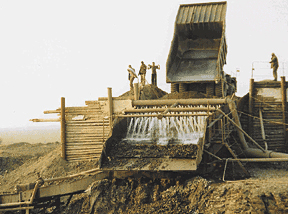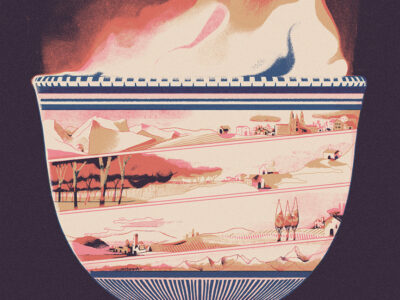
In Kolyma, where Gulag prisoners once toiled, the search for gold has always been a battle for survival.
By Alexei Dmitriev
The midsummer sun was still high when we finally made it to the Belichan claim after an 11-hour drive on the “Road of Bones,” as this unpaved track built by Gulag prisoners in the 1930s is known here. I had not been to a Russian gold mine before, but the sight of bulldozer and grader skeletons in different degrees of disassembly, some looking like plain rusted scrap, did taint my anticipation. The backdrop of a deserted Belichan village in the distance—its caved-in roofs and burned-out windows—and the smoke from forest fires crawling in from the surrounding hills gave the panorama an eerie appearance of a battlefield. A battle raged for Kolyma gold, and it was still too early to tell the winners from the losers.

To Russians, the word Kolyma evokes images of misery and death in Stalin labor camps in this desolate area of northeastern Russia, 4,500 miles from Moscow. Of almost two million prisoners that went through Kolyma between 1932 and 1957, more than 500,000 perished—victims of hunger, sickness, or firing squad—while mining gold for the system that sought to destroy them.
I traveled to Kolyma last August, in the company of a producer and a local, influential friend, to begin work on a documentary. I wanted to see how germane its past was in the aftermath of Russia’s recent shift to capitalism and democracy. I found out that for both the Gulag prisoners and today’s prospectors, the battle for gold was the battle for survival.
In the aftermath of perestroika (the Russian word for restructuring) in the late 1980s, the state subsidies needed to support gold mining in Kolyma ran out. In 1993, the Russian government took a drastic step; it denationalized gold mining and gave local governments authority over concession licenses, production volumes, and foreign investment. Instead of addressing the urgent matter of improving social conditions, the move kindled “Wild East” capitalist practices and attracted adventurers in search of quick riches. In Kolyma alone, 270 licenses have been given to prospector cooperatives, or artels, as they are known in Russia, but only 180 of them have survived to deliver gold to a local refinery.
When we arrived, the prospectors were enjoying a smoke between shifts. Fasil, the stocky, polo-shirt clad owner of the Belichan cooperative, made the introductions. Ivan Ivanovich, a lanky, gray-haired foreman with a face like Popeye’s, has been mining gold for the state for 25 years and recently went out on his own, only to be swindled by an unscrupulous partner. “He wouldn’t be toiling here now if he hadn’t got a new wife at home,” said Rustam, a worker with a mouth full of gold teeth. I asked if they got any gold today. “Could be better,” Ivanovich said and spat on the ground. “Last week we got a 700-gram nugget, but today’s total take is just over a kilo.”
The new shift was about to take its positions. “Come, I’ll show you the works,” said Ivanovich, and with a royal gesture he invited me inside a seriously patched-up Toyota. We were about to see what he laconically referred to as the pribor (Russian for “device”). The Toyota wheezed around waterlogged pits and gravel hips known as “tailings”—a scarred wasteland left behind after gold mining. Flickers of magenta willow herb were the only signs of life in this desert.
Ivanovich used the ride to explain the works: “In a placer mine like Belichan, loose gold is extracted from alluvial sand, gravel, and clay. When it was first mined in the 1940s, prisoners armed with only picks, spades, and wheelbarrows working in minus-40-degree cold would remove six to ten feet of topsoil to expose the gold pay-dirt. A lot of lives to spare back then … ” He paused for a moment. “Now the ’dozers do the job.”
Once the ice melts, the pay dirt is washed through a grate of parallel bars called grizzly. The grizzly catches larger stones, allowing the mix of gravel, sand, and water to run down into the sluice-box. Gold is 19 times heavier than water and deposits at the bottom.
The mysterious pribor turned out to be an unappeasable monster that devoured and regurgitated hundreds of cubic feet of earth. Every four minutes giant trucks backed up to the edge of a pit and emptied their 25-ton holds of gravel and earth over a mechanized grizzly; its plates moved in waves, pushing larger boulders off into the pit. A giant sprinkler sprayed water over the pay-dirt, and the mixture rushed down into three parallel sluice-boxes, 30-foot-long troughs with metal ridges called riffles along the bottom to trap the gold. The roar of trucks, the clanking of the chains that moved the grizzly plates, and the noise of rocks banging against the metal was deafening.
The next morning Rustam, sporting the same fatigues and a shiny golden smile, picked us up in a beaten-up Russian jeep. On the way we passed a roadblock manned by OMON, the special police force. “Officially, Kolyma produces about 30 tons of gold per year,” Rustam explained. “I’d say about another five is mined illegally. With 30 percent of the locals living below the poverty line, panning gold is the only chance for some to make ends meet. We call these prospectors khishniki [predators],” he said. “Nobody knows how much gold they pan and how much the police recover—if you know what I mean.”
A 20-minute off-road drive took us to a remote part of the tailings field dotted with water-filled gullies. Rustam spotted some khishniki there yesterday. Today they were gone, leaving behind empty food cans and tools. “They take no risks. If OMON spots them, they may not make it out of here in one piece.” Rustam slapped a mosquito on his neck. “These guys are a desperate and hardy bunch. Look, they are getting ready for winter.” He pointed to piles of firewood covered with oil drums cut into halves and a few old tires. “They will burn tires and wood to melt snow in these oil drums to sluice the gold. You should see them in spring, faces black from tire smoke, clothes reduced to oily shreds.” Tired of mosquitoes swarming around him, Rustam lit a cigarette.
A craving for panning swept over me. The idea amused Rustam: “OK, I’ll show you what to do.” He pointed to a mini-sluice left behind by the khishniki. It was a cradle-like box four feet long and two feet wide with one open end to allow water and earth to escape. Its bottom is lined with riffled rubber mats. We propped the sluice at an angle and placed the hopper, a huge scoop with a perforated bottom, over its elevated end. I emptied a couple of pail loads of gravel and sand into the hopper, then poured water over the mixture. Rustam rocked the hopper, stirring its muddy contents with a stick.
When only large stones were left in the hopper, I set it aside and inspected the riffles. Nothing. More earth and water and—is it really happening to me?—tiny yellow specks shone on the mat.
After 20 more minutes we ended up with roughly half a gram. The sun was shining brighter, the mosquitoes were kinder, and the obsessive thought was to dig, haul, and wash until the first snowfall. Call it beginner’s luck or the highest concentration of gold in Kolyma, but if a dozen pails brought in this much, the daily yield from one pribor fed by 25-ton trucks every four minutes should be close to 25 kilos. I asked Rustam how much off I was. He delivered his trademark golden smile: “The requisition will start in half an hour; we’ll see.”
Ivanovich, two teenaged lads in rubber boots, and an AK47-toting roly-poly guard were already waiting for us. Ivanovich opened the seals on the three sluice-boxes so the rocks and sand could be cleared out. Small nuggets and gold sand were now visible on the riffled mats. “Should be about a kilo and a quarter,” said Ivanovich matter-of-factly. One after another the mats were placed into a round red canister and rinsed. The guard sealed the canister and we all squeezed into the jeep. The catch did not come close to the estimate made at the pinnacle of my gold-mining luck.
We drove up to a fence with barbed wire on top and a ferociously barking Rottweiler inside. The guard petted the dog, and I entered the “secure zone.” In a shack the same teenaged lads washed the canisters’ contents on a vibrating table, separating the golden and plain sand under the watchful eye of a somber matron with heavy make-up, the cooperative’s geologist. The dim light and the damp air emphasized their apathy. Looking at the swift brushes in the washers’ hands, I thought about gold’s beauty and value coming from such unsightly multiples as thousands of square miles of defaced land, faces blackened from tire soot, and these skinny red hands dancing for hours in icy water.
We did find the khishniki the next day. The two men stopped digging and stared at my camera in bewilderment. A big German shepherd kept them company, and me at a respectable distance.
Both men dig for gold to support their families. Pavel used to be a metal worker; Vladimir had taught at a school that closed down. They showed an official permit to “explore” but not to mine gold. “If you don’t have any papers, the OMON would first burn your gear,” said Pavel. “Then they’d beat you up ‘for the prophylactic purposes.’”
Their day is off to a good start if they get a lift. Otherwise, it is an hour-and-a-half walk to the site followed by 14 hours of digging and shoveling. “The water is too far from here to sluice, but this old river bank is a decent spot, so we sift through the soil looking for larger specks and small nuggets,” Pavel explained. “On a good day we get four grams that we can sell for about 200 rubles ($6.66) per gram.” To whom? “We do not really care, as long as they pay.”
With a ticket to Moscow costing 12,000 rubles ($400), it is unlikely they would move. When winter comes, “We’ll shovel coal at the central boiler that heats the village,” he said. “We may get lucky next summer, though. A couple of villages nearby will be razed and rumor has it that they sit on some real gold.”
Before leaving I asked to take their picture. Pavel did not mind, but Vladimir turned away, looking toward the rocky riverbank. Today when I look at the photograph and see him kneeling, his fatigue-clad back to the camera, and his hand petting the dog, I think of the many other faceless captives of economic reforms, locked without barbed wire in Kolyma. For them the change of seasons means only a change of shovels.
Alexei Dmitriev G’88 is a native of Russia who lives in Potomac, Maryland. After a brief career of selling telecom services in South Asia, he has switched to making documentaries.




